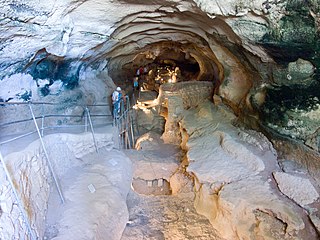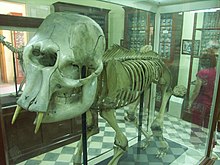Għar Dalam
| Għar Dalam
|
||
|---|---|---|
|
Look into the cave |
||
| Location: | Malta | |
|
Geographic location: |
35 ° 50 '9 " N , 14 ° 31' 39" E | |
|
|
||
| Geology: | Coral limestone | |
| Type: | Karst cave | |
| Discovery: | First mentioned in 1647 | |
| Show cave since: | 1933 | |
| Lighting: | electric | |
| Overall length: | 145 meters | |
| Length of the show cave area: |
80 meters | |
| Particularities: | Fossil deposit | |
The Għar Dalam ( mt .: Cave of Darkness ) is a karst cave in the southeast of the island of Malta , near the town of Birżebbuġa and only about 500 m from St George's Bay. It has a maximum width of 18 m, is up to 8 m high and leads about 145 m into the limestone cliffs. The entrance, which is only 15.5 m above sea level, opens like a gate with a width of 11 m and a height of 4.5 m. The cave is an important fossil deposit and a popular excursion destination, it has been included in the National Inventory of the Cultural Assets of the Maltese Islands .
Emergence
The Għar Dalam is embedded in the rock formation of the Lower Coral Limestone, which is tertiary age. It opens to the valley of the Wied Dalam, which runs across the cave. The river valley was originally much higher and had only cut deeper over time. The cave was initially created by seepage water that penetrated through crevices into the subsoil and created an underground cavity through weathering of the solution . In the Pleistocene , especially in the cold periods , the Mediterranean region had a much more humid climate with more rain. As a result, the river periodically swelled and eroded the limestone. In the Middle Pleistocene, the course of the river then reached the height of today's cave entrance and thus exposed the cavity. The Għar Dalam only represents the northeastern part of this once subterranean cavity. At the opposite end of the Wied Dalam valley there is a wider, somewhat smaller cavity called the "Second Cave" and encompasses the southwestern part of this former karst channel. In the late Middle Pleistocene and the New Pleistocene, the river filled the cave with sediments that were more than 5 m thick. Today the river valley is much deeper than the cave entrance.
history
The cave was first mentioned in 1647 by the Maltese historian Giovanni Francesco Abela (1582–1655). Għar Dalam became known as a site of fossil bones in 1865, when the Genoese geologist Arturo Issel (1842–1922) found the first bones of hippos here in search of the remains of Neanderthals . In 1892, English teacher John Henry Cooke carried out several excavations which uncovered large numbers of Pleistocene animal bones. The success of these investigations meant that the cave was visited by numerous fossil collectors over the next 30 years. It was not until 1922 that new scientific investigations began on a larger scale. These were initialized by Gertrude Caton-Thompson (1888–1985), a British archaeologist , and later continued by her Maltese colleague Joseph G. Baldacchino (1894–1974). The huge amount of finds soon led to a storage problem, which is why a house was built over the cave by 1930. The cave itself was opened to visitors in March 1933, while excavations ended in 1937. A museum had been set up on site just a year earlier.
During the Second World War , during the Second Great Siege of Malta , the cave served the population as a refuge from bombings . They also use the British forces from October 1940 to store aircraft fuel. The cave and museum did not reopen until 1947. However, no major excavations were carried out after the end of the Second World War. A few smaller ones were made by the German paleontologist Gerhard Storch in the 1970s, which affected all sediment layers. Today the cave has been largely cleared, only two sediment columns have been preserved as reference profiles to clarify the stratigraphy . In addition to the old museum building, a new, much larger exhibition hall opened in 2002.
Paleontological and archaeological importance
Paleontological finds
The cave is of great importance for both paleontology and archeology. The lowest layer, which is fossil-free, has an assumed age of around 180,000 years, while the hippopotamus layer on top belonged to the last warm period ( Eem warm period , 126,000 to 115,000 years ago). It represents a compact bone breccia. In this layer, the researchers found numerous bones of the Pleistocene animal world, such as the eponymous hippopotamus, which comes in two size variations with Hippopotamus pentlandi (slightly smaller than today's hippopotamus) and Hippopotamus melitensis (very small pygmy hippopotamus) . Also of importance are the dwarf elephants found here , which also exist in two differently sized species. So reached Elephas mnaidriensis a shoulder height of 1.9 m to 2, and weighed about 2.5 tons. In contrast, its relative Elephas falconeri was only 0.9 to 1.1 m high with a reconstructed weight of 170 kg. Besides these, the remains of several other animals like were Bilche ( Leithie Cartei ), various bats and a rich bird life found.
The next fossil-bearing layer is the Cervus or Hirsch layer , which rests on a gravelly sediment and probably belongs to the outgoing last glacial period (125,000 to 11,700 years ago). Their age is given as 18,000 years. Numerous remains of the red deer ( Cervus elaphus ) were found in this layer , which also shows clear dwarfism. There are also fossils of small predators such as the brown bear ( Ursus arctos ), wolf ( Canis lupus ) and red fox ( Vulpes vulpes ), as well as voles ( Pitymys melitensis ), giant swans, turtles and amphibians .
The importance of the fauna of Għar Dalam lies in the appearance of small mammals, the continental representatives of which reach significantly larger dimensions. This typical island dwarfing mainly affects the physically large species. It is noteworthy that in Għar Dalam, elephants and hippopotamuses each have two differently sized forms. At least for the elephants, different phases of settlement on the island of Malta were considered. Elephas falconeri first colonized the island and achieved complete dwarfing, while Elephas mnaidriensis appeared later and only partially dwarfed until its extinction. Since all animal finds in the cave seem to be of European origin, it is assumed that Malta was once connected to mainland Europe (Sicily) and not, as is often assumed, to Africa.
Archaeological finds
Traces of human settlement have been found in the uppermost layer of Għar Dalam, which is divided into two and is called the culture layer or ceramic layer . The lower part contained relics from the Neolithic . These include ceramic shards, tools made of flint and obsidian and pierced animal teeth (including those of wolves) or mussel shells as pendants. In addition, there were remains of domesticated animals, mainly cattle but also domestic sheep and goats . The ceramic shows typical impressed decorations and is therefore assigned to the imprint culture . This cultural stage corresponds to the Għar Dalam phase in the local Maltese archaeological stratigraphy. The finds represent the remains of the earliest human settlement in Malta and belong to the period from 5,200 to 4,500 BC. The upper part of this layer also contained numerous ceramic remains, which due to their characteristics, however, date to the Phoenician period around 700 BC. Belong to.
tourism
Għar Dalam is one of the most popular tourist destinations in Malta. An 80 meter long illuminated part of the cave is open to the public. A paved road was laid out. Today there is a small museum above the main entrance, in which the most important finds are exhibited.
In 1980, however, numerous valuable objects were stolen - including four pygmy elephant tusks and the skull of a Neolithic child .
Nearby is the Għar Ħasan cave .
literature
- Joachim von Freeden: Malta and the architecture of its megalithic temples. Scientific Book Society, Darmstadt 1993, ISBN 3-534-11012-9 .
Individual evidence
- ↑ a b c d e f George Zammit Maempel: Għar Dalam. Cave and deposits. Malta, 1989
- ↑ a b Heritage Malta: Għar Dalam Cave and Museum. ( PDF ( Memento from September 5, 2012 in the Internet Archive ) Web archive copy of the original from September 5, 2012)
- ^ Maria Rita Palombo: Elephants in miniature. In: Harald Meller (Hrsg.): Elefantenreich - Eine Fossilwelt in Europa. Halle / Saale, 2010, pp. 275–295
- ↑ Lucia Caloi, Tassos Kotsakis, Maria Rita Palombo and Carmelio Petronio: The Pleistocene dwarf elephants of Mediterranean islands. In: Jeheskel Shoshani and Pascal Tassy (eds.): The Proboscidea. Evolution and palaeoecology of the Elephants and their relatives. Oxford, New York, Tokyo, 1996, pp. 234-239


